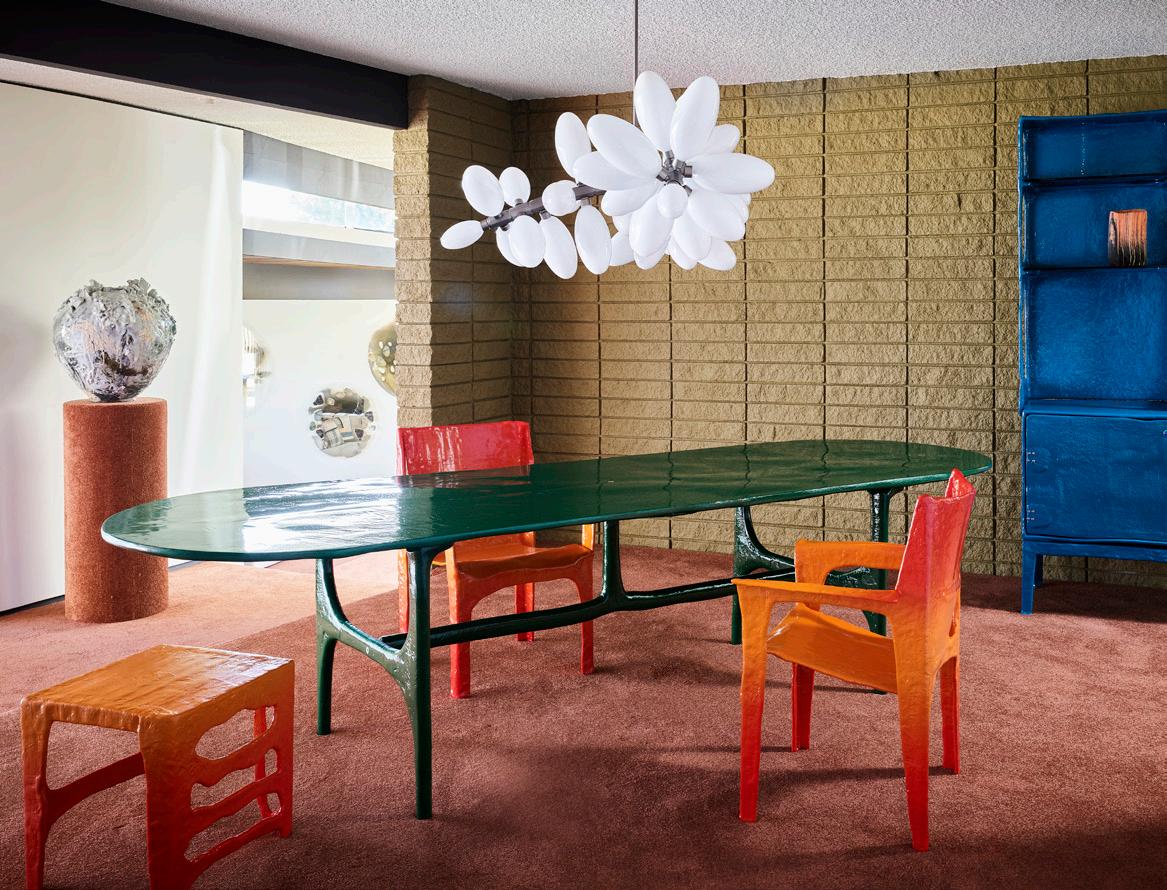
4 minute read
Casa Perfect, brittyn dion
Casa Perfect
Once owned by Elvis Presley, this Beverly Hills home finds humor in perfectionism.
The functions of our world today are fueled by screens, digital posts, and capitalist efforts. Models for domestic living are no longer made during spontaneous face to face encounters or even Sunday evening soap operas. Instead, aspiring frameworks are made in almost every moment, with the unrelenting presentations of ideals through humanity’s novel and constant exposure to marketed media. Between 2010 and 2015, the years in which smartphone accessibility rose, visits to collegiate counseling centers jumped by 30%. In a world where every image can be retouched, every pose can be captured from hundreds of angles, and every sentence can be edited, why wouldn’t the impressionable generation strive to curate perfection to match? It is no secret that mental health disorders have risen in congruence with the rise of social media. Every day the average American social media user is bombarded with images. These images are meant to draw curiosity and intrigue their viewer’s gaze with tempting placements and visual appeal. After short exposure, the viewer begins to internalize the image. Soon enough, viewers find themselves subconsciously recreating the images, aspiring to their aesthetic asymmetry and meticulous messes. Recent trends push for transparency from the subjects in social media photos. “Natural Beauty” is a term that stems from this push; but, what is natural beauty when a subject can take hundreds of photos, choose the most perfect one, and rely on many free apps to edit the image further? Due to this technological determinism, we are now able to change what ‘natural’ means. Long gone are the days of a quick, candid snapshot’s honest depiction of a lazy beach day. Now a candid picture entails 15 minutes of changing angles and even more time devoted to free tuning apps; the photo tinged rosy with light filters and edges smoothed with a single screen tap. From Glossier advertisements to messy buns and greenery, all Instagram photos captioned with ‘natural’ ooze perfection. 51
Casa Perfect, an annual art gallery hosted by The Future Perfect, attempts to embrace imperfections for their truth. Sometimes the things that don’t fit a standardized mold are what makes a space, person, or event sensational. These galleries, installed in beautiful and inaccessible homes, capitalize off of the same tactics utilized by colonized social media. They state: “Conceived with a comedy performance in mind, the Wonky collection is made using only basic tools, without precise measurement. This playful approach in response to materials and process leads to a sometimes uncertain outcome for each piece - imbuing the collection with a sense of chaos. Bubbles appear in the fiberglass, neither surface nor paint is perfect, and symmetry is never achieved. The triumph of the Wonky collection is in how its forms express the hand, humor, and vulnerability of the author.” The February 2020 gallery, hosted in a Los Angeles estate, melds contemporary design with 1970s architecture, a strategy central to the ‘natural beauty’ style much of the western world is trapped in. The exhibit features a peculiar lamp that seems unfinished. Only when lined perfectly with the closet doors behind it, does it become apparent that this lamp boasts a grin. It becomes a smile under two round handles on the sliding closet doors. This image comes together to the audience only when viewing from a singular angle, one that may take a while to find. Peculiarly a dining room/kitchen area frames three pieces made of multicolored balloons reminiscent of childhood balloon animals. Even a cooking appliance, made of this toxic and dangerous flammable plastic, looks right inside of such a lavish home. One of the first rooms entered by visitors touches on this same theme of flammability with heat. A lighting fixture, which seems to have once been quite pretty and ornamental, loses its privileged connotations by its visible melting, the prongs of light slowly bend toward the floor away from their fixed positions. Before entering the climactic backyard, guests are confronted with an uncomfortably stuffed couch, perhaps mirroring the bodies of those privileged enough to live in a home such as this one- overstimulated and too filled with media to digest appropriately. The couch offers a final nod to the oddities of the house. The Casa Perfect gallery seems to laugh at the new and dangerous standardization of perfection. This push for natural behavior in a world that offers such accessible ways to edit and curate only feeds the same beast it intends to confront. Perhaps The Future Perfect senses the dangerous path and uses this art to alleviate the want for perfection. It’s okay to break the mold. In speaking of her own society’s hegemonic ways, Virginia Woolf wrote her famed short work of nonfiction, A Room of One’s Own. It’s doubtful she required literal exhibitioned rooms in her feminist call to action; however, her ideas are reflective of Casa Perfect’s message. In her words, there’s “No need to hurry. No need to sparkle. No need to be anybody but oneself.”














